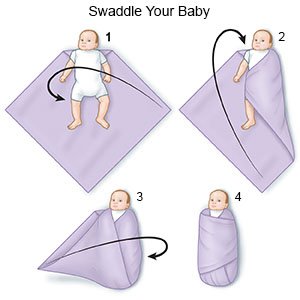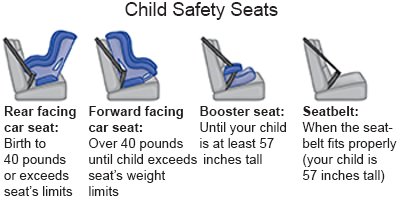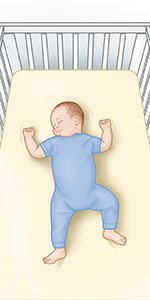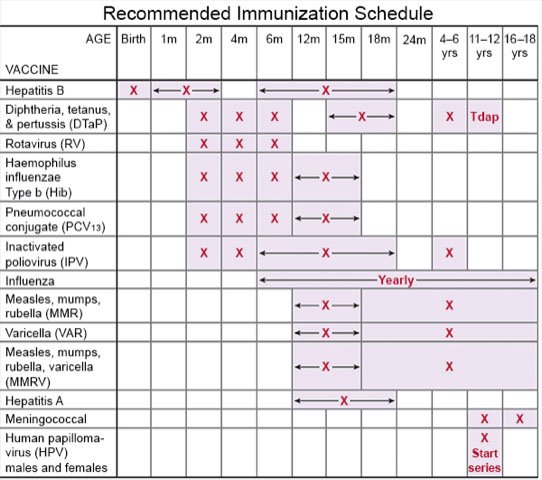Well Child Visit at 2 Months
Medically reviewed by Drugs.com. Last updated on Aug 4, 2025.
Explore by milestone
What is a well child visit?
A well child visit is when your child sees a pediatrician to prevent health problems. Well child visits are used to track your child's growth and development. It is also a time for you to ask questions and to get information on how to keep your child safe. Write down your questions so you remember to ask them. Your child should have regular well child visits from birth to 17 years.
What development milestones may my baby reach at 2 months?
Each baby develops at his or her own pace. Your baby might have already reached the following milestones, or he or she may reach them later:
- Focus on faces or objects and follow them as they move
- Recognize faces and voices
- Coo or make soft gurgling sounds
- Cry in different ways depending on what he or she needs
- Smile when someone talks to, plays with, or smiles at him or her
- Lift his or her head when he or she is placed on his or her tummy, and keep his or her head lifted for short periods
- Grasp an object placed in his or her hand
- Calm himself or herself by putting his or her hands to his or her mouth or sucking his or her fingers or thumb
What can I do when my baby cries?
Your baby may cry because he or she is hungry. He or she may have a wet diaper, or be hot or cold. He or she may cry for no reason you can find. Your baby may cry more often in the evening or late afternoon. It can be hard to listen to your baby cry and not be able to calm him or her down. Ask for help and take a break if you feel stressed or overwhelmed. Never shake your baby to try to stop his or her crying. This can cause blindness or brain damage. The following may help comfort your baby:
- Hold your baby skin to skin and rock him or her, or swaddle him or her in a soft blanket.

- Gently pat your baby's back or chest. Stroke or rub his or her head.
- Quietly sing or talk to your baby, or play soft, soothing music.
- Put your baby in his or her car seat and take him or her for a drive, or go for a stroller ride.
- Burp your baby to get rid of extra gas.
- Give your baby a soothing, warm bath.
What can I do to keep my baby safe in the car?
- Always place your baby in a rear-facing car seat. Choose a seat that meets the Federal Motor Vehicle Safety Standard 213. Make sure the child safety seat has a harness and clip. Also make sure that the harness and clips fit snugly against your baby. There should be no more than a finger width of space between the strap and your baby's chest. Ask your pediatrician for more information on car safety seats.

- Always put your baby's car seat in the back seat. Never put your baby's car seat in the front. This will help prevent him or her from being injured in an accident.
What can I do to keep my baby safe at home?
- Do not give your baby medicine unless directed by his or her pediatrician. Ask for directions if you do not know how to give the medicine. If your baby misses a dose, do not double the next dose. Ask how to make up the missed dose.Do not give aspirin to children younger than 18 years. Your child could develop Reye syndrome if he or she has the flu or a fever and takes aspirin. Reye syndrome can cause life-threatening brain and liver damage. Check your child's medicine labels for aspirin or salicylates.
- Do not leave your baby on a changing table, couch, bed, or infant seat alone. Your baby could roll or push himself or herself off. Keep one hand on your baby as you change his or her diaper or clothes.
- Never leave your baby alone in the bathtub or sink. A baby can drown in less than 1 inch of water.
- Always test the water temperature before you give your baby a bath. Test the water on your wrist before putting your baby in the bath to make sure it is not too hot. If you have a bath thermometer, the water temperature should be 90°F to 100°F (32.3°C to 37.8°C). Keep your faucet water temperature lower than 120°F.
- Never leave your baby in a playpen or crib with the drop-side down. Your baby could fall and be injured. Make sure the drop-side is locked in place.
How should I lay my baby down to sleep?
It is very important to lay your baby down to sleep in safe surroundings. This can greatly reduce his or her risk for SIDS. Tell grandparents, babysitters, and anyone else who cares for your baby the following rules:
- Put your baby on his or her back to sleep. Do this every time he or she sleeps (naps and at night). Do this even if he or she sleeps more soundly on his or her stomach or side. Your baby is less likely to choke on spit-up or vomit if he or she sleeps on his or her back.

- Put your baby on a firm, flat surface to sleep. Your baby should sleep in a crib, bassinet, or cradle that meets the safety standards of the Consumer Product Safety Commission (CPSC). Do not let him or her sleep on pillows, waterbeds, soft mattresses, quilts, beanbags, or other soft surfaces. Move your baby to his or her bed if he or she falls asleep in a car seat, stroller, or swing. He or she may change positions in a sitting device and not be able to breathe well.
- Put your baby to sleep in a crib or bassinet that has firm sides. The rails around your baby's crib should not be more than 2⅜ inches apart. A mesh crib should have small openings less than ¼ inch.
- Put your baby in his or her own bed. A crib or bassinet in your room, near your bed, is the safest place for your baby to sleep. Never let him or her sleep in bed with you. Never let him or her sleep on a couch or recliner.
- Do not leave soft objects or loose bedding in his or her crib. Your baby's bed should contain only a mattress covered with a fitted bottom sheet. Use a sheet that is made for the mattress. Do not put pillows, bumpers, comforters, or stuffed animals in the bed. Dress your baby in a sleep sack or other sleep clothing before you put him or her down to sleep. Do not use loose blankets. If you must use a blanket, tuck it around the mattress.
- Do not let your baby get too hot. Keep the room at a temperature that is comfortable for an adult. Never dress him or her in more than 1 layer more than you would wear. Do not cover your baby's face or head while he or she sleeps. Your baby is too hot if he or she is sweating or his or her chest feels hot.
- Do not raise the head of your baby's bed. Your baby could slide or roll into a position that makes it hard for him or her to breathe.
What do I need to know about feeding my baby?
Breast milk or iron-fortified formula is the only food your baby needs for the first 4 to 6 months of life. Do not give your baby any other food besides breast milk or formula.
- Breast milk gives your baby the best nutrition. It also has antibodies and other substances that help protect your baby's immune system. Babies should breastfeed for about 10 to 20 minutes or longer on each breast. Your baby will need 8 to 12 feedings every 24 hours. If he or she sleeps for more than 4 hours at one time, wake him or her up to eat.
- Iron-fortified formula also provides all the nutrients your baby needs. Formula is available in a concentrated liquid or powder form. You need to add water to these formulas. Follow the directions when you mix the formula so your baby gets the right amount of nutrients. There is also a ready-to-feed formula that does not need to be mixed with water. Ask the pediatrician which formula is right for your baby. Your baby will drink about 2 to 3 ounces of formula every 2 to 3 hours when he or she is first born. As he or she gets older, he or she will drink between 26 to 36 ounces each day. When he or she starts to sleep for longer periods, he or she will still need to feed 6 to 8 times in 24 hours.
- Do not overfeed your baby. Overfeeding means your baby gets too many calories during a feeding. This may cause him or her to gain weight too fast. Do not try to continue to feed your baby when he or she is no longer hungry.
- Do not add baby cereal to the bottle. Overfeeding can happen if you add baby cereal to formula or breast milk. You can make more if your baby is still hungry after he or she finishes a bottle.
- Do not use a microwave to heat your baby's bottle. The milk or formula will not heat evenly and will have spots that are very hot. Your baby's face or mouth could be burned. You can warm the milk or formula quickly by placing the bottle in a pot of warm water for a few minutes.
- Burp your baby during the middle of the feeding or after he or she is done feeding. Hold your baby against your shoulder. Put one of your hands under your baby's bottom. Gently rub or pat his or her back with your other hand. You can also sit your baby on your lap with his or her head leaning forward. Support his or her chest and head with your hand. Gently rub or pat his or her back with your other hand. Your baby's neck may not be strong enough to hold his or her head up. Until your baby's neck gets stronger, you must always support his or her head while you hold him or her. If your baby's head falls backward, he or she may get a neck injury.
- Do not prop a bottle in your baby's mouth or let him or her lie flat during a feeding. He or she might choke. If your baby lies down during a feeding, the milk may flow into his or her middle ear and cause an infection.
What do I need to know about peanut allergies?
- Peanut allergies may be prevented by giving young babies peanut products. If your baby has severe eczema or an egg allergy, he or she is at risk for a peanut allergy. Your baby needs to be tested before he or she has a peanut product. Talk to your baby's healthcare provider. If your baby tests positive, the first peanut product must be given in the provider's office. The first taste may be when your baby is 4 to 6 months of age.
- A peanut allergy test is not needed if your baby has mild to moderate eczema. Peanut products can be given around 6 months of age. Talk to your baby's provider before you give the first taste.
- If your baby does not have eczema, talk to his or her provider. He or she may say it is okay to give peanut products at 4 to 6 months of age.
- Do not give your baby chunky peanut butter or whole peanuts. He or she could choke. Give your baby smooth peanut butter or foods made with peanut butter.
How can I help my baby get physical activity?
Your baby needs physical activity so his or her muscles can develop. Encourage your baby to be active through play. The following are some ways that you can encourage your baby to be active:
- Hang a mobile over his or her crib to motivate him or her to reach for it.
- Gently turn, roll, bounce, and sway your baby to help increase his or her muscle strength. When your baby is 3 months old, place him or her on your lap, facing you. Hold your baby's hands and help him or her stand. Be sure to support his or her head if he or she cannot hold it steady.
- Play with your baby on the floor. Place your baby on his or her tummy. Tummy time helps your baby learn to hold his or her head up. Put a toy just out of his or her reach. This may motivate him or her to roll over as he or she tries to reach it.
What are other ways I can care for my baby?
- Create feeding and sleeping routines for your baby. Set a regular schedule for naps and bed time. Give your baby more frequent feedings during the day. This may help him or her have a longer period of sleep of 4 to 5 hours at night.
- Do not smoke near your baby. Do not let anyone else smoke near your baby. Do not smoke in your home or vehicle. Smoke from cigarettes or cigars can cause asthma or breathing problems in your baby.
- Take an infant CPR and first aid class. These classes will help teach you how to care for your baby in an emergency. Ask your baby's pediatrician where you can take these classes.
How can I care for myself during this time?
- Go to all postpartum check-up visits. Your healthcare providers will check your health. Tell them if you have any questions or concerns about your health. They can also help you create or update meal plans. This can help you make sure you are getting enough calories and nutrients, especially if you are breastfeeding. Talk to your providers about an exercise plan. Exercise, such as walking, can help increase your energy levels, improve your mood, and manage your weight. Your providers will tell you how much activity to get each day, and which activities are best for you.
- Find time for yourself. Ask a friend, family member, or your partner to watch the baby. Do activities that you enjoy and help you relax. Consider joining a support group with other women who recently had babies if you have not joined one already. It may be helpful to share information about caring for your babies. You can also talk about how you are feeling emotionally and physically.
- Talk to your baby's pediatrician about postpartum depression. You may have had screening for postpartum depression during your baby's last well child visit. Screening may also be part of this visit. Screening means your baby's pediatrician will ask if you feel sad, depressed, or very tired. These feelings can be signs of postpartum depression. Tell him or her about any new or worsening problems you or your baby had since your last visit. Also describe anything that makes you feel worse or better. The pediatrician can help you get treatment, such as talk therapy, medicines, or both.
What do I need to know about my baby's next well child visit?
Your baby's pediatrician will tell you when to bring him or her in again. The next well child visit is usually at 4 months. Contact your baby's pediatrician if you have questions or concerns about your baby's health or care before the next visit. Your baby may need vaccines at the next well child visit. Your provider will tell you which vaccines your baby needs and when your baby should get them.
 |
Care Agreement
You have the right to help plan your baby's care. Learn about your baby's health condition and how it may be treated. Discuss treatment options with your baby's healthcare providers to decide what care you want for your baby. The above information is an educational aid only. It is not intended as medical advice for individual conditions or treatments. Talk to your doctor, nurse or pharmacist before following any medical regimen to see if it is safe and effective for you.© Copyright Merative 2025 Information is for End User's use only and may not be sold, redistributed or otherwise used for commercial purposes.
Learn more about Well Child Visit at 2 Months
Care guides
Further information
Always consult your healthcare provider to ensure the information displayed on this page applies to your personal circumstances.
